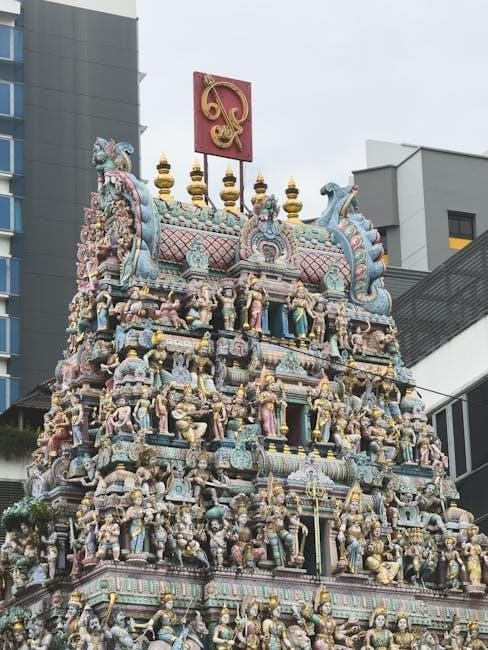Sri Rudram Namakam Chamakam is a sacred Vedic hymn dedicated to Lord Shiva‚ part of the Yajur Veda. It consists of 11 Anuvakas‚ praising Shiva’s attributes and seeking blessings‚ protection‚ and liberation. The Namakam and Chamakam sections are revered for their spiritual significance‚ offering a pathway to enlightenment and well-being. This ancient text is widely studied and recited‚ with PDF resources available for easy access to its profound verses and interpretations.

1.1 Overview of the Significance of Sri Rudram
Sri Rudram‚ a cornerstone of Vedic literature‚ holds immense spiritual and philosophical significance. As part of the Yajur Veda‚ it is a powerful invocation of Lord Shiva‚ comprising 11 Anuvakas that extol His divine attributes. The hymn is not merely a prayer but a profound expression of devotion‚ seeking blessings‚ protection‚ and liberation from adversity. Its verses are believed to embody the essence of Shiva’s omnipotence and benevolence‚ making it a focal point in rituals and ceremonies. Reciting Sri Rudram is considered a means to attain spiritual growth‚ forgiveness‚ and inner peace. It is also revered for its ability to ward off negative energies and bring prosperity. The text’s historical roots and its enduring relevance in Hindu tradition underscore its sacred status. For devotees‚ Sri Rudram serves as a bridge between the mortal and the divine‚ offering solace‚ strength‚ and enlightenment. Its timeless appeal continues to inspire seekers of truth and harmony.
1.2 Importance of Namakam and Chamakam
Namakam and Chamakam are integral sections of Sri Rudram‚ each holding unique significance. The Namakam‚ or “Namaste‚” is a series of salutations to Lord Shiva‚ acknowledging His divine forms and attributes. It emphasizes devotion‚ surrender‚ and the pursuit of divine grace. The Chamakam‚ on the other hand‚ is a prayer for the fulfillment of desires‚ material prosperity‚ and spiritual growth. Together‚ they balance the aspirant’s life by addressing both worldly needs and transcendental goals.
The recitation of Namakam and Chamakam is believed to purify the mind‚ bestow blessings‚ and protect against adversity. These sections are often chanted in rituals and ceremonies‚ offering a powerful means to connect with the divine. Their verses are rich in symbolism‚ highlighting Shiva’s role as both destroyer of evil and granter of liberation. The combination of Namakam’s devotion and Chamakam’s aspirational prayers makes Sri Rudram a holistic spiritual practice‚ resonating with seekers of both material and spiritual well-being.
1.3 Purpose of the Article
This article aims to provide a comprehensive understanding of the Sri Rudram Namakam Chamakam‚ focusing on its spiritual significance and practical applications. It seeks to explore the deeper meanings embedded in the hymns‚ their historical context‚ and their role in Vedic rituals. By examining the structure and composition of the text‚ the article endeavors to illuminate its importance in Hindu spirituality and its relevance in modern times.
The primary purpose is to guide readers in understanding the benefits of reciting Sri Rudram‚ including its impact on spiritual growth‚ material well-being‚ and emotional healing. Additionally‚ the article highlights reliable sources for accessing the Sri Rudram Namakam Chamakam PDF‚ ensuring that devotees and scholars can easily reference this sacred text. By bridging tradition and accessibility‚ the article serves as a valuable resource for those seeking to deepen their connection with Lord Shiva and Vedic wisdom.
Structure and Composition of Sri Rudram

Sri Rudram is divided into Namakam and Chamakam‚ comprising 11 Anuvakas. It features Vedic chants praising Shiva‚ with hymns seeking blessings‚ protection‚ and liberation. The structure reflects its sacred origins and spiritual depth‚ guiding devotees in worship and meditation.
2.1 The Division into Namakam and Chamakam

Sri Rudram is divided into two main sections: Namakam and Chamakam. Namakam‚ comprising the first 80 verses‚ is a eulogy to Lord Shiva‚ extolling his virtues and seeking his blessings. Chamakam‚ with 70 verses‚ follows as a prayer to Shiva‚ requesting fulfillment of desires such as prosperity‚ health‚ and spiritual enlightenment. Together‚ they form a comprehensive worship‚ balancing praise and supplication. The division reflects the dual aspects of devotion: admiration and plea. Both sections are integral to Vedic rituals‚ often recited for spiritual growth and material well-being. The PDF versions of Sri Rudram Namakam Chamakam are widely available‚ providing devotees with accessible resources for study and recitation. These texts are cherished for their deep spiritual insights and poetic beauty‚ making them central to Shiva worship. The structured division ensures a holistic approach to connecting with the divine‚ fostering a deeper understanding of Shiva’s essence. The PDF format preserves the sacred chants‚ ensuring their longevity and accessibility for future generations.
2.2 The 11 Anuvakas of Sri Rudram
Sri Rudram is structured into 11 Anuvakas‚ or sections‚ which are integral to its recitation and interpretation. These Anuvakas are not randomly divided but follow a systematic pattern‚ reflecting the deeper spiritual and philosophical essence of the text. Each Anuvaka serves as a building block‚ progressively elevating the devotee’s connection with Lord Shiva. The first eight Anuvakas focus on the glorification of Shiva’s attributes and powers‚ while the latter three shift toward seeking blessings and fulfillment of desires. This division is intentional‚ guiding the reciter from reverence to supplication. The 11 Anuvakas are meticulously arranged to create a spiritual rhythm‚ enhancing the devotee’s meditative experience. In PDF versions of Sri Rudram Namakam Chamakam‚ these Anuvakas are clearly marked‚ aiding in systematic study and recitation. This structured composition underscores the Vedic emphasis on order and harmony‚ making Sri Rudram a masterpiece of spiritual literature.
2.3 The Role of Vedic Chants in Sri Rudram
Vedic chants play a pivotal role in Sri Rudram‚ as they are the medium through which the sacred hymns are conveyed. These chants are not merely recitations but are imbued with specific vibrations and rhythms that resonate deeply with the universe. The Vedic tradition emphasizes the importance of proper pronunciation and intonation‚ as these elements are believed to unlock the divine energy embedded in the mantras. In Sri Rudram‚ the chants are used to invoke Lord Shiva’s blessings‚ purify the mind‚ and create a sacred atmosphere conducive to spiritual growth. The chants also serve as a bridge between the material and spiritual realms‚ allowing devotees to connect with the divine on a profound level. Furthermore‚ the collective chanting of Sri Rudram fosters a sense of unity and harmony among participants‚ amplifying the positive effects of the recitation. The inclusion of Vedic chants in Sri Rudram underscores its timeless relevance and spiritual potency.

The Significance of Sri Rudram in Vedic Literature
Sri Rudram holds a revered place in Vedic literature‚ offering profound spiritual insights and philosophical depth. Its divine hymns and chants are integral to worship and self-realization‚ reflecting the essence of Vedic wisdom and tradition.
3.1 Historical Background and Origins
Sri Rudram‚ an integral part of the Krishna Yajurveda‚ is deeply rooted in Vedic tradition‚ tracing its origins to ancient India. It is divided into Namakam and Chamakam‚ with Namakam focusing on worship and Chamakam on the fulfillment of desires. Composed by Sage Yajnavalkya‚ it is believed to have been revealed to him through divine inspiration. The text is embedded in the Taittiriya Samhita‚ highlighting its antiquity and sacredness. Sri Rudram is not merely a prayer but a powerful medium to connect with the divine‚ embodying the essence of Vedic spirituality. Its historical significance lies in its role as a foundational text for rituals and philosophical discourse. Over centuries‚ it has been meticulously preserved and passed down through generations‚ maintaining its purity and relevance. The origins of Sri Rudram are intertwined with the evolution of Vedic literature‚ making it a cornerstone of Hindu religious and cultural practices.
3.2 Spiritual and Philosophical Insights
Sri Rudram is a treasure trove of spiritual and philosophical wisdom‚ offering profound insights into the nature of the divine and human existence. It emphasizes the importance of devotion (bhakti) and the pursuit of truth‚ while also highlighting the interplay between the individual self (jiva) and the universal consciousness (Shiva). The Namakam and Chamakam collectively represent the duality of human aspirations—worship and the fulfillment of desires—while ultimately pointing toward the unity of existence. The text underscores the concept of duality‚ where Shiva is both the formless absolute and the manifested universe. This duality is central to its philosophical depth. By reciting Sri Rudram‚ one is reminded of the transient nature of worldly desires and the eternal pursuit of self-realization. It also explores the idea of divine grace (anugraha) and the balance between good and evil‚ order and chaos‚ reflecting the harmony inherent in the universe. The text thus serves as a spiritual guide‚ aligning human consciousness with the cosmic order for inner peace and liberation.
3.3 Cultural Impact and Reverence
Sri Rudram has had a profound cultural impact‚ deeply embedding itself in Hindu traditions and rituals. It is revered as a sacred text‚ often recited in temples‚ homes‚ and during religious ceremonies‚ fostering a sense of spiritual and cultural unity. The Namakam and Chamakam are integral to Vedic rituals‚ with their chants and hymns resonating in the hearts of devotees. This text has inspired countless scholars‚ priests‚ and laypeople‚ shaping their understanding of Hindu philosophy and practice. Its influence extends beyond religion‚ influencing art‚ music‚ and literature‚ as its verses are often reflected in classical compositions and cultural performances; The reverence for Sri Rudram is evident in its inclusion in daily prayers and special occasions‚ such as weddings and festivals‚ where its recitation is believed to invoke divine blessings and harmony. Over centuries‚ it has become a symbol of cultural heritage‚ preserving Vedic traditions and connecting generations to their roots. This enduring reverence underscores its role as a cornerstone of Hindu culture and spirituality.
Key Verses and Their Interpretations
The Namakam and Chamakam contain profound verses invoking Shiva’s blessings and creation’s cycle. Key verses highlight divine attributes and cosmic order‚ offering spiritual insights into existence and liberation. Their interpretations reveal Vedic philosophy’s depth and universal truths.
4.1 Analysis of Namakam Verses
The Namakam verses in Sri Rudram are a divine invocation of Lord Shiva‚ emphasizing his cosmic role and divine attributes. These verses are structured in 11 Anuvakas‚ each with a specific rhythm and spiritual significance. Key verses describe Shiva as the creator‚ preserver‚ and destroyer of the universe‚ highlighting his omnipotence and benevolence. The Namakam also explores themes of devotion‚ surrender‚ and the pursuit of liberation. Certain verses‚ such as those praising Shiva’s cosmic dance and his role in maintaining cosmic order‚ are particularly revered. The language is rich in symbolism‚ often using natural imagery to convey spiritual truths. The Namakam’s verses are not only a theological masterpiece but also a guide for spiritual growth. Reciting these verses is believed to bring inner peace‚ clarity‚ and a deeper connection to the divine. Their profound meanings and emotional depth make them central to Vedic worship and meditation. PDF resources often include detailed commentaries to aid in understanding these sacred verses.

4.2 Deep Dive into Chamakam Verses
The Chamakam verses serve as a complement to the Namakam‚ focusing on the benevolent aspects of Lord Shiva and his divine grace. Comprising 11 Anuvakas‚ the Chamakam is a heartfelt prayer seeking divine blessings for prosperity‚ knowledge‚ and liberation. The verses are rich in imagery‚ describing Shiva’s cosmic dance‚ his Trishul‚ and his role as the protector of the universe. A key theme is gratitude‚ as the devotee acknowledges Shiva’s countless blessings and seeks continued guidance. Certain verses highlight the importance of righteousness and ethical living. The Chamakam also emphasizes the pursuit of both material well-being and spiritual growth. Its recitation is believed to purify the mind‚ bestow clarity of thought‚ and grant the ability to overcome life’s challenges. In rituals‚ the Chamakam is often chanted to invoke Shiva’s blessings for specific desires. PDF resources provide detailed interpretations‚ making the Chamakam accessible for deeper spiritual understanding and practice. Its verses are a testament to the timeless wisdom of Vedic literature.
4.3 Symbolism and Hidden Meanings
The verses of Sri Rudram are rich in symbolism‚ offering deeper spiritual insights and philosophical truths. The Namakam and Chamakam are not just prayers but also encoded wisdom about the universe and human existence. For instance‚ the imagery of Rudra as the destroyer of evil symbolizes the removal of negative tendencies within oneself. The Trishul‚ or trident‚ represents the balance of creation‚ preservation‚ and destruction. Similarly‚ the mention of natural elements like fire‚ water‚ and earth reflects their cosmic significance and their role in sustaining life. The verses also symbolize the pursuit of Dharma (righteousness)‚ Artha (wealth)‚ Kama (desires)‚ and Moksha (liberation)‚ guiding followers to live a balanced and purposeful life. The hidden meanings often emphasize the unity of existence and the ultimate goal of self-realization. Studying these symbols through PDF resources provides a deeper understanding of the text’s spiritual and philosophical dimensions‚ making it a valuable tool for seekers of wisdom.

Benefits of Reciting Sri Rudram
Reciting Sri Rudram Namakam Chamakam offers profound benefits‚ including spiritual growth‚ material success‚ and emotional healing. It brings mental clarity‚ inner peace‚ and alignment with divine energy‚ fostering a deeper connection to the universe.
5.1 Spiritual Growth and Enlightenment
Reciting Sri Rudram Namakam Chamakam is a powerful practice for spiritual growth and enlightenment. It helps deepen one’s connection with the divine‚ fostering a sense of oneness with the universe. The chants purify the mind‚ removing negative energies and ego‚ and cultivate humility and devotion. By invoking Lord Shiva‚ practitioners seek liberation from worldly bonds and attain self-realization. Regular recitation enhances meditation‚ allowing individuals to transcend material consciousness and experience divine bliss. The sacred verses also promote emotional and mental clarity‚ enabling one to embrace life’s challenges with equanimity. Ultimately‚ Sri Rudram Namakam Chamakam serves as a spiritual tool for seekers aiming to align with cosmic energy and achieve inner peace. Its profound vibrations elevate consciousness‚ guiding followers toward enlightenment and eternal harmony.
5.2 Material Benefits and Well-being
Reciting Sri Rudram Namakam Chamakam is believed to bring numerous material benefits and enhance overall well-being. The chants are said to attract prosperity‚ wealth‚ and success in various endeavors. By appeasing Lord Shiva‚ devotees seek blessings for career growth‚ financial stability‚ and abundance. The hymns are also known to ward off negative energies‚ adversities‚ and obstacles in life. Regular recitation fosters a harmonious family life‚ improving relationships and ensuring the well-being of loved ones. Additionally‚ it is believed to grant protection from diseases and promote physical health. The vibrations of the mantras create a positive environment‚ contributing to mental peace and stability. Many practitioners report improved luck and opportunities after reciting Sri Rudram‚ making it a popular choice for those seeking both spiritual and material fulfillment. Thus‚ it serves as a holistic practice for achieving balance in life and securing divine grace for worldly comforts.
5.3 Emotional and Mental Healing
Reciting Sri Rudram Namakam Chamakam is also known for its profound impact on emotional and mental well-being. The divine vibrations of the mantras help in calming the mind‚ reducing stress‚ and alleviating anxiety. The chants are believed to purify the heart and soul‚ fostering emotional balance and stability. Many devotees have reported feeling a deep sense of inner peace and tranquility after reciting the hymns regularly. The Namakam and Chamakam verses are particularly effective in addressing emotional turmoil‚ as they invoke the blessings of Lord Shiva‚ who is considered the ultimate healer of suffering. By focusing on the spiritual energy of the chants‚ practitioners can overcome negative emotions and cultivate a sense of self-awareness. This practice is also said to enhance mental clarity‚ improve concentration‚ and promote a positive outlook on life. Thus‚ Sri Rudram serves as a powerful tool for emotional and mental healing‚ offering solace and strength to those seeking inner harmony.
The Rituals and Practices Associated with Sri Rudram
The rituals involve proper pronunciation of mantras‚ maintaining a pure mind‚ and reciting with devotion. Regular practice‚ ideally daily or during auspicious occasions‚ is recommended. Priests often perform ceremonies‚ and offerings like flowers and water are common. Chanting with a Rudraksha mala enhances focus and spiritual connection.
6.1 Proper Way to Recite Namakam and Chamakam
Reciting Sri Rudram Namakam and Chamakam requires adherence to Vedic traditions and proper etiquette. Begin with purification rituals like Achamana and Pranayama to cleanse the mind and body. Sit in a comfortable‚ cross-legged posture on a sacred mat‚ facing east or north. Maintain mental focus and chant clearly‚ emphasizing proper pronunciation and intonation. Recite Namakam first‚ followed by Chamakam‚ as they are intricately linked. Use a Rudraksha mala for counting verses to maintain concentration. Offer flowers or water to Lord Shiva during recitation‚ symbolizing devotion. Avoid distractions and ensure a calm environment. Recitation during auspicious times‚ like early morning or evening‚ enhances spiritual benefits. Seek guidance from a qualified guru to master the correct recitation technique. Regular practice strengthens devotion and ensures the ritual’s efficacy. By following these guidelines‚ one can experience the profound spiritual and emotional benefits of Sri Rudram.

6.2 Rituals and Ceremonies Involving Sri Rudram
Rituals and ceremonies involving Sri Rudram are deeply rooted in Vedic traditions and are performed to seek divine blessings. One of the most prominent rituals is the Rudra Puja‚ where Sri Rudram is chanted to appease Lord Shiva. This ceremony is often conducted during auspicious occasions like festivals‚ weddings‚ or to resolve planetary afflictions. The ritual begins with the invocation of Lord Shiva‚ followed by offerings of flowers‚ fruits‚ and incense. The chanting of Namakam and Chamakam is accompanied by the pouring of water or ghee into the sacred fire‚ symbolizing purification and surrender. In some traditions‚ abhishekam (hydration ritual) is performed on a Shiva Linga while reciting the hymns. These ceremonies are believed to cleanse past sins‚ bring prosperity‚ and grant spiritual enlightenment. The presence of a qualified priest ensures the ritual’s authenticity and effectiveness. Participation in such ceremonies fosters a sense of community and deepens devotion to Lord Shiva.
6.3 Role of Mantras and Their Pronunciation
The role of mantras in Sri Rudram is pivotal‚ as they are considered powerful tools for spiritual growth and divine connection. Each mantra in Namakam and Chamakam is meticulously crafted to evoke specific vibrations‚ aligning the reciter with cosmic energy. Pronunciation is paramount‚ as even slight deviations can alter the mantra’s efficacy. Vedic scholars emphasize the importance of maintaining the correct pitch‚ tone‚ and rhythm‚ as these elements are believed to unlock the mantra’s hidden potential. The mantras are designed to invoke Lord Shiva’s blessings‚ offering protection‚ healing‚ and enlightenment. Regular practice‚ ideally under the guidance of a qualified guru‚ is recommended to master the nuances of pronunciation. PDF resources on Sri Rudram often include diacritical marks and audio aids to assist learners in perfecting their recitation. Properly pronounced mantras not only enhance the spiritual experience but also amplify their transformative power‚ making them a cornerstone of Sri Rudram’s practice.

Sri Rudram Namakam Chamakam PDF Resources
Authentic PDF resources for Sri Rudram Namakam Chamakam are available on trusted spiritual websites and platforms. These resources provide detailed scriptures‚ chants‚ and meanings‚ aiding devotees in understanding and reciting the hymns effectively for spiritual growth and enlightenment.

7.1 Reliable Sources for Downloading the PDF
Obtaining an authentic Sri Rudram Namakam Chamakam PDF is essential for accurate recitation and understanding. Reputable sources include official Vedic websites‚ such as Vedabase‚ and trusted e-book platforms like HolyBooks. Additionally‚ spiritual organizations like Vedic Pathashala and Sri Vidya Temple offer downloadable versions. These sources ensure the text is preserved in its original form‚ maintaining the integrity of the Vedic chants and meanings. When downloading‚ verify the PDF’s authenticity by cross-referencing with established scriptures or consulting scholars. Many platforms also provide translations and commentaries‚ aiding devotees in grasping the deeper significance of the hymns. Always opt for websites with a proven track record to avoid corrupted or misinterpreted versions.
- Official Vedic websites like Vedabase and Vedic Pathashala;
- E-book platforms such as HolyBooks and Google Books.
- Spiritual organizations and temple websites.
Ensure the PDF is downloaded from trusted sources to maintain the sanctity and accuracy of the ancient text.
